
The Genomics Revolution: How DNA Profiling Is Personalizing Ovarian and Uterine Cancer Treatment Plans
Introduction For decades, the treatment of ovarian and uterine cancers has largely relied on a ‘one-size-fits-all’ approach. Chemotherapy, while often effective in shrinking tumors, frequently







